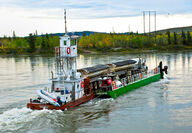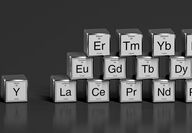Sorted by date Results 251 - 275 of 518

The Pebble Mine project advanced to the final step of the permitting process would produce 320 million pounds of copper; 363,000 ounces of gold; 15 million pounds of molybdenum; 1.8 million oz of silver; and 12,000 kilograms of rhenium annually over the first 20 years of mining, according to the results of a new preliminary economic assessment published by Northern Dynasty Minerals Ltd. on Sept. 9. In addition to the proposed 20-year-mine submitted for permitting, the PEA...

Throughout the relatively short modern history of Alaska, many nameless and oft unrecognized explorers have contributed to the Last Frontier state in ways that future generations will never be able to truly appreciate. This, however, is not the case for Bill Ellis, an explorer and geologist who has gifted his knowledge and experience for nearly half a century and personifies the attitude needed to succeed in mineral exploration, optimism. As if by providence, Bill was born in...

Alaska Gov. Mike Dunleavy highlighted the importance of cooperation between Alaska Native Claims Settlement Act (ANCSA) corporations and their shareholders, state organizations, and mining companies during a recent visit to the Ambler Mining District in Northwest Alaska. "Collaboration begins with trust," he said. "When we work together and develop our state's resources responsibly, we can achieve incredible outcomes for all Alaskans." Having spent nearly two decades as a...

Southeast Alaska is at a unique crossroads in its management of the Tongass National Forest. How will reimposition of the 2001 Roadless Rule impact development of natural resources like geothermal, hydroelectric, and mineral resources? As stewards of these public lands, we need deliberative and balanced Forest Service consideration of the best use of and access to these resources to protect and sustain Southeast communities and their economic future. The Forest Service needs...

Ucore Rare Metals Inc. Aug. 11 announced that it has joined the National Mining Association, which advocates for United States mining to Congress, the White House, federal agencies, and others in Washington, D.C. Ucore's joining with the more than 250 other corporate and organization members of NMA coincides with its preparation to construct the Alaska Strategic Metals Complex rare earth element processing facility by the end of 2023. "Ucore's membership in the National...

From reinstating the Roadless Rule in the Tongass Forest to replacing the General Mining Law of 1872, federal regulations being proposed by President Joe Biden threaten to rain on a parade of strong metals prices, growing demand for critical minerals, and robust investments into mineral exploration and mining across Alaska. "We recommend Congress develop legislation to replace outdated mining laws including the General Mining Law (GML) of 1872 governing locatable minerals...

After raising C$10 million earlier this year, Graphite One Inc. is collecting the final bits of data needed for a prefeasibility study that details the company's vision to establish a United States supply chain for the coated spherical graphite used as an anode material in the lithium-ion batteries that power electric vehicles and store intermittent renewable energy. The first segment of this supply chain is the world-class Graphite Creek mine project about 35 miles north of...

While copper did not make it onto the list of 35 minerals and metals critical to the United States, the red metal's criticality to the global transition to renewable energy and electric mobility cannot be overstated. No matter which battery chemistries power tomorrow's electric vehicles, what renewable energy solutions recharge those EVs, or if rare earth magnets are used to generate that electricity and propel those vehicles more efficiently, any path to a decarbonized...

Although new cases of COVID-19 are still appearing throughout the nation in general and Alaska in particular, at the moment they are hovering at the 40-per-day level apparently. The vaccine is working. Operation Warp Speed succeeded in making it safe for most people to go most places most of the time safely. This is good news, especially for those who make their living in remote locations, such as exploration geologists and placer miners. It is fair to say, I think, that the m...

Alaska contains minerals essential to the national defense, renewable energy and electronics industries. Finding those minerals, however, can be difficult in such a vast and geologically challenging state. Hyperspectral imagery can help as Alaska's summer exploration season approaches. The University of Alaska Fairbanks Geophysical Institute has the only hyperspectral imaging facility in the state at its Hyperspectral Imaging Laboratory created in 2014 as the brainchild of...

From the Coast Mountains in the west to the lower parts of the Yukon's Boreal forest in the north, the Cassiar Mountain range in the east, and the headwaters of the Nass and Skeena Rivers in the south, an ancestral indigenous people known as Tahltans has called Northern British Columbia home for thousands of years. According to a 2003 sourcebook prepared by the Museum of Anthropology entitled "Mehodihi: Well-Known Traditions of Tahltan People," the Tahltan Nation, which...

Ucore Rare Metals Inc. believes the Biden administration's newly announced strategy to strengthen America's supply chains aligns with its own vision to disrupt China's dominance of the rare earth elements supply chain in the United States. "We are very pleased with the White House's concern for REEs and its efforts to spur the domestic production of critical materials," said Ucore Rare Metals Chairman and CEO Pat Ryan. Based on the feedback from a 100-day American supply...

Alaska, Northern British Columbia, and the Yukon are home to a dozen advanced stage exploration and mine projects hosting billions of pounds of copper ready to deliver to a world demanding massive amounts of this conductive metal for the green energy and electric mobility transition envisioned over the next three decades. In its report, "Copper is the new oil," Goldman Sachs forecasts that the electrification of transportation and decarbonization of electrical generation...

From a world-class graphite deposit in the Northwest to rare earths on the Southeast Panhandle, Alaska has the potential to offer a sustainable and secure supply to meet the coming explosive demand for the minerals and metals crucial to the renewable energy and electric vehicle sectors in North America and around the globe. International Finance Corporation, part of the World Bank Group, estimates that this shift to low-carbon energy and electric mobility will create nearly...

Alaska mines produced roughly $3.16 billion worth of non-fuel minerals during 2020, a slight increase over the $3.13 billion during 2019, according to Mineral Commodity Summaries 2021 published by the U.S. Geological Survey on Feb. 2 The rise in Alaska mine production value is largely due to higher gold output at Alaska's large mines and record setting prices for the precious metal last year. According to early estimates by the Alaska Division of Geological & Geophysical...

Strong metal prices and an infusion of cash from notable resource investors helped to salvage much of a 2020 mineral exploration season in Alaska that became lethargic with disruptions, delays, and shelving of field programs infected by the COVID-19 pandemic early in the year. At its onset, 2020 was looking like it would be the best year for Alaska's mining sector in a decade. Australia-based mining companies were slated to invest nearly US$100 million in mineral exploration...

For many mining companies eyeing prospects in Canada's far north, 2020 presented insurmountable challenges. But for the few explorers and producers focused on Northwest Territories, the year proved to be quite productive, even as a global coronavirus pandemic added expensive restrictions to already costly campaigns. Rigorous restrictions imposed by local and federal officials to quell potential outbreaks of the disease at mining camps and prevent its spread to local...

The Alaska Industrial Development and Export Authority unanimously passed a resolution authorizing the formalization of a preliminary due-diligence process for a potential US$3 million to US$5 million investment for the development and commercial-scale operation of the rare earths separation facility Ucore Rare Metals Inc. plans to build near the Southeast Alaska port town of Ketchikan. Development of this Alaska Strategic Metals Complex, or Alaska SMC, is the first step towar...

Whether it is the exponential growth in electric vehicles traveling global highways, the massive need for storing energy at solar and wind electrical generating facilities, or cutting the cords on our electronic devices, the world is becoming increasingly dependent on lithium-ion batteries. And this is driving up the demand for cobalt, a critical safety ingredient in the cathodes of these energy storage cells. "Globally, the leading use is in the manufacture of cathode materia...

Wind turbines, solar panels, and the batteries that store the electricity these renewable energy sources generate are creating new demands for an array of minerals and metals, many of which are not mined in the United States. Recognizing that mines lie at the front end of America's expanding renewable energy supply chains, federal officials have determined that critical mining projects must be eligible for Fast-41, a program established in 2015 to improve the timeliness,...

America's supply of tungsten, an extremely durable metal that is vital to a broad range of American industrial sectors, is at high-risk. A recent U.S. Geological Survey assessment to identify which mineral commodities are most at risk to supply disruptions ranked tungsten near the top of the list – alongside rare earth elements, cobalt and graphite, platinum group metals and tungsten. Like many of its neighbors at the top of the mineral commodity supply risk list, much of the...

When you consider the 17 rare earths and six platinum metals individually, more than 50 of the elements on the periodic table have been deemed critical to the economic wellbeing and security of the United States, a list that worries the White House and many policymakers in Washington, D.C. To sort the hierarchy of this expansive list, the U.S. Geological Survey has developed a tool that helps identify which mineral commodities lying at the crux of America's manufacturing...

Due to their vital importance to American manufacturing and the fact that 100% of U.S. supply comes from overseas, primarily China, rare earth elements top the list of minerals and metals deemed critical to the United States. When the U.S. Geological Survey plugged in 52 critical mineral commodities into a recently developed supply risk tool, six rare earth elements – dysprosium (No. 1), yttrium (No. 2), neodymium (No. 3), lanthanum (No. 5), cerium (No. 6) and praseodymium (...

The rapidly accelerating expansion of the electric vehicle and renewable energy sectors is driving enormous new demand for graphite, a major ingredient in lithium-ion batteries. The World Bank forecasts that low-carbon energy technologies, primarily lithium-ion batteries, will require 4.5 million metric tons of graphite per year by 2050, which is about a 500% increase over 2018 levels and a 318% increase over the total graphite produced in 2019. "Graphite demand increases in...

In addition to dealing a major blow to the economy, the COVID-19 pandemic has shined a spotlight on a chink in the United States' economic and security armor – an overreliance on foreign countries for the minerals and metals that lie at the frontend of American supply chains. "The COVID-19 pandemic has shown how delicate our supply chains are and that should be a wakeup call for all of us," Senate Committee on Energy & Natural Resources Chair Lisa Murkowski, R-Alaska, said dur...